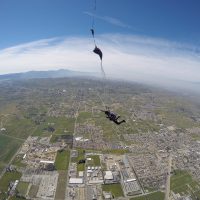Run Away! How to plan a safe break off
Monday, April 26, 2021

- Christy Frikken
- 4/26/21
- 0
- Basic Flying Skills, Safety
The break-off plan establishes how we get away from other skydivers for safe deployment at the end of a skydive. The plan includes the altitude we stop skydiving, the direction everyone will go when they leave the formation, and the deployment altitudes.
Altitude
Choose an altitude based on the number of people, the group’s experience level, and members’ desired deployment altitude. In general, a break-off altitude should be at least 1500 feet above the planned deployment for groups five or less and at least 2000 feet for groups of six or more. You can add more altitude if there are newer skydivers, unfamiliar landing areas, or other circumstances that could use an extra safety margin. See the Skydiver’s Information Manual (SIM) section on break-off recommendation for more information.
Direction
You should depart from the center of the group and choose an angle that splits the people’s distance beside you. Be aware of where others are tracking, and fan out in a way that gives everyone maximum space.
 |
 |
Turn away from the center to maximize distance from each other.
Remember that you are not just turning 180 degrees from the direction you are facing for more complex shapes. Turn away from the center and leave in a way that divides the sky equally for other flyers. Your trajectory of travel might not be 180 degrees from your heading.
 |
 |
Different shapes require more awareness to find the angle from the center.
NEVER adjust your track when flying with a group to avoid the line of flight! The rule of “do not track line along the line of flight” is intended (and vital!) for tracking jumps or solo jumps, but it does not apply to common formation skydives. It can be dangerous; if skydivers do this in a group jump, they will cluster and increase the chances of hitting other people in the group. Hopefully, it is intuitive that you are fanning-out at the end of a formation skydive with a normal break-off, your immediate and obvious danger is the other jumpers on your OWN dive. If there was enough separation between groups, you do not need to worry about line-of-flight (until you are under a canopy and clear again).
To reiterate: “do not track line along the line of flight” is a critical rule for tracking jumps or solo jumps, but poses a danger in group formation jumps.
Also, you should never adjust your track to try to make it back to the dropzone. That means you should not change your track’s direction to try to make it back, nor shorten your track if you are far out. Your only priority is to get clear air between your teammates and camera person for a safe deployment at this moment of the skydive.
Multiple Points
If your jump consists of multiple points, it is useful to walk through a break-off from each one. Helping jumpers see who will be next to them and how they should leave at various points in the skydive keeps things smooth and safe.
Video Person
Suppose your group has a video person filming from above. In that case, they will traditionally deploy in the center of the formation as the group breaks off if this is the plan, clear far away from the center of the formation to give her room!
Going Low
If you go low on a skydive, do your best to safely return to the group while keeping them in visual range. Keep working your way back as best you can until you arrive at the planned break-off altitude, at which time you should track away as expected. Staying near and leaving at the correct time allows the group to see you and accommodate the low jumper during break-off. Learn more about recovering from going low.
Stay safer by making a great plan that is high enough, adds enough separation, considers each formation, and has a contingency strategy.
Want to make sure you don’t miss an article? Like Fury Coaching on Facebook to stay in the loop.




